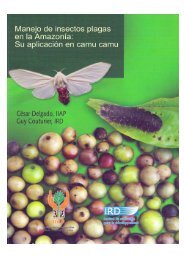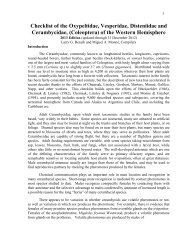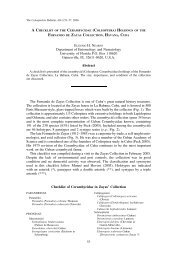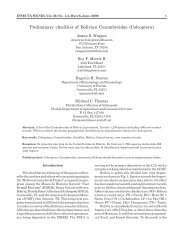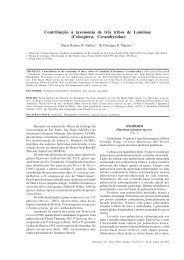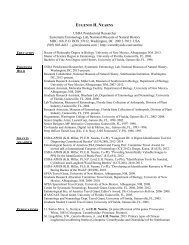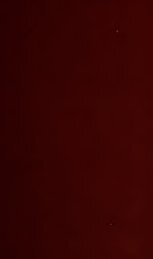Create successful ePaper yourself
Turn your PDF publications into a flip-book with our unique Google optimized e-Paper software.
170 THE TRIBE ONCIDERINI<br />
tinctly impressed; no distinct punctures preent. Scutellum transverse, sides only<br />
feebly oblique, slightly arcuate; apex broad, slightly rounded. Elytra with sides<br />
subparallel, apices separately rounded; disk with a scarcely perceptible gibbosity<br />
toward base, entire basal two fifths coarsely, rather densely punctate, thence to apex<br />
punctures much finer, obsolete; humeri fairly prominent, the anterior margin<br />
straight, strongly oblique, angle with a large, rounded tubercle. Prosternum uni<br />
formly, rather strongly expanded froll apex to base; mesosternum elongate, ungu<br />
late each side, expanded gradually to apex, which is broadly emarginate, a median<br />
distinct linear impression on basal half. Antennae slightly longer than body (from<br />
seventh wanting) ; very sparsely fimbriate beneath to fifth segment; scape rather<br />
elongate, clavate on apical half, not rugose at base; third segment one-half longer<br />
than first, very feebly sinuous; fourth one and one-quarter times length of first,<br />
rest shorter, gradually diminishing.<br />
LENGTH 14.5 mm.; width 5.5 mm.<br />
Type locality.-Guiana.<br />
Distribution.-North-central South America.<br />
BRAZIL : '2; Rio Caiary-Uappes, Amazonas, 1906; (H. Schmidt); [A.M.N.H.].<br />
Hesychotypa crocea Dillon and Dillon, spec. nov.<br />
PLATE VI, FIGunE 15.<br />
Somewhat related to H. jaspidea but very distinct from it and<br />
all other known species, in that the elytral ochraceous maculation<br />
is much heavier, more extensive, leaving a very definite common<br />
brown fascia just behind middle which is widest at suture; anten<br />
nae slender, elongate, feebly annulate; antennal horns slender,<br />
acute, more elongate than in female jaspidea.<br />
FEMALE. Elongate-ovate, rather robust, subcylindrical; dark r.eddish-brown or<br />
piceous, densely pubescent. Head ochraccous pubescent, a short, wedge-shaped vitta<br />
each side of median line on vertex and another behind antennal tubercles, brown;<br />
front margined each side with denser ochraceous; genae each with two upright vittae<br />
of hoary gray. Pronotum ochraceous, disk at middle of each side with a broad,<br />
oblique brown vitta, medially three indistinct vittae of the same color, one at base,<br />
anteriorly a longer one each side of middle, at extreme sides a curv.cd brown line<br />
extending obliquely anteriorly and downward from above lateral tubercle to front<br />
margin, all brown lines and vittae margined with pale gray. Scutellum with central<br />
area golden brown, rest pale gray. Elytra each with two long vitt!\e ex tending from<br />
basal margin where they are more or less coalescent, to middle, a curved vitta on<br />
humerus, three short subequal vittae each side near middle, four or five short, ir<br />
regular vittae on each apex, and several small maculae near suture, all bright och<br />
mcous irregularly margined with pale gray, the interspaces and a broad, common<br />
fascia behind middle, greatly expanded medially, golden brown. Body beneath and<br />
legs reddish-brown, pale gray pubescent; sides of sterna coarsely maculate with<br />
bright ochraceous; abdomen each side with two rows of bright ochraccous maculae,



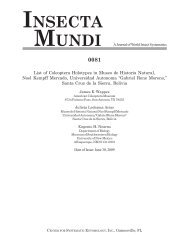
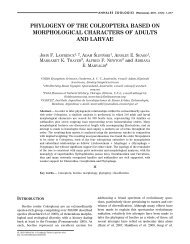


![Coleoptera. Vol. I. [Longicornia. Part I.]](https://img.yumpu.com/41202793/1/180x260/coleoptera-vol-i-longicornia-part-i.jpg?quality=85)
